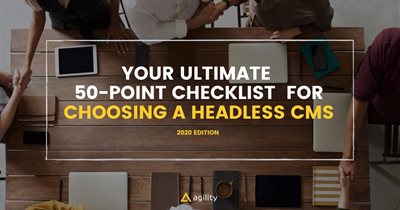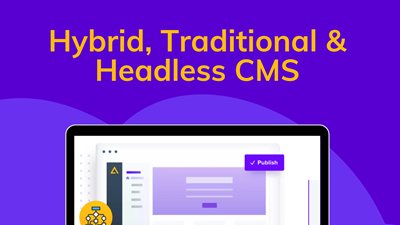The Ultimate 50-Point Checklist On Which Headless CMS To Choose
Your one-stop checklist for evaluating any headless CMS on the market.


Choosing the best headless CMS is not something that should be done on a whim.
Sure, forward-thinking brands should be looking to migrate from a traditional CMS to a headless one if they haven’t done so already, but that doesn’t mean you should be hasty.
With the sheer number of options in the market, it’s crucial that you evaluate the pros and cons of every content management system, while also keeping in mind that there’s no one size fits all when it comes to choosing the best headless CMS for your company.
That’s why prior knowledge of your CMS requirements is fundamental to making the right choice. To help you evaluate your shortlisted headless systems, we’ve listed 50 points for you to consider before you sign on any dotted line.
Using our 50-point checklist, you’ll catch issues and avoid pitfalls including:
- Choosing a headless CMS that’s affordable today, but unaffordable once you scale
- Choosing a headless CMS with limited marketer-friendly features and developer labour intensive
- Choosing a headless CMS that is really just a traditional CMS with APIs tacked on
Click here to open the 50-point checklist for choosing a headless CMS.
The What, Why, and How of Going Headless
Contrary to a traditional CMS, a headless CMS is entirely decoupled from the presentation layer or frontend, which is referred to as the “head”. Meanwhile, backend or CMS itself behaves as your content repository and content management system, known as the “body”.
When you separate your content repository “body” from its presentation layer “head,” it becomes a headless CMS. What truly makes a headless CMS better than a traditional CMS is its content-first approach with full APIs to access and display content in any way desired. With this approach, a headless CMS enables you to author your content through the RESTful API and deliver that content wherever you need it — not just to a templated website or application.
There are many things to consider and little time to do it, but choosing the right CMS is an exciting new beginning for your digital future! Enjoy!
We’re here to help you pick the right system for your company. One that’s easy to scale and that adjusts to your needs.
The Checklist is organized into 9 categories:
- First Considerations
- Budget
- Speed and Scalability
- Infrastructure
- Security and Permissions
- Content Management
- APIs and Extensibility
- Analytics
- Support
First Considerations when choosing a new Headless CMS
Ask yourself...
What are your internal resource capabilities?
If you have in-house developers, keeping them in the decision-making process will be a key way to ensure that whatever headless CMS platform you choose uses programming languages that your developers are familiar with.
What impact will this platform have on your business?
Before choosing your headless CMS, you need to assess whether or not the platform will help your company or not, especially if you’re thinking about switching to a different provider.
Budget Considerations when choosing a new Headless CMS
Headless CMS can start with Free and go up to as high as 5k+ monthly. Implementation, training and content architecture can cost extra.
Will it be too costly to scale in 12 months?
Let’s say you want to scale your website after a successful implementation. See if your CMS helps you do that or if it’s going to end up being too costly to scale it in the long run.
Want to find out other considerations we recommend? Access your full list of 50 questions here.
Speed and Scalability when choosing a new Headless CMS
Speed is everything these days. It takes time to deploy but you should also consider how time-efficient it is going to be to use the CMS not only for developers but also for the marketing team.
If you need your website to be ready soon, a headless CMS will save you time by allowing your marketing team to work on content in parallel with developers working on code. Just make sure you use a Content First approach and take Content Architecture seriously.
Can you start small and scale later?
As the amount of content grows, the problem becomes how to manage it from the creation process to the need to access it later. You need a CMS that can help you scale from the ground up.
What time-saving features does it include?
How will the CMs actually help your content managers and authors save time? Look for features like customizable content workflows, global content search, and task management.

About the Author
Joel is CTO at Agility. His first job, though, is as a father to 2 amazing humans.
Joining Agility in 2005, he has over 20 years of experience in software development and product management. He embraced cloud technology as a groundbreaking concept over a decade ago, and he continues to help customers adopt new technology with hybrid frameworks and the Jamstack. He holds a degree from The University of Guelph in English and Computer Science. He's led Agility CMS to many awards and accolades during his tenure such as being named the Best Cloud CMS by CMS Critic, as a leader on G2.com for Headless CMS, and a leader in Customer Experience on Gartner Peer Insights.
As CTO, Joel oversees the Product team, as well as working closely with the Growth and Customer Success teams. When he's not kicking butt with Agility, Joel coaches high-school football and directs musical theatre. Learn more about Joel HERE.



